
get your own
via

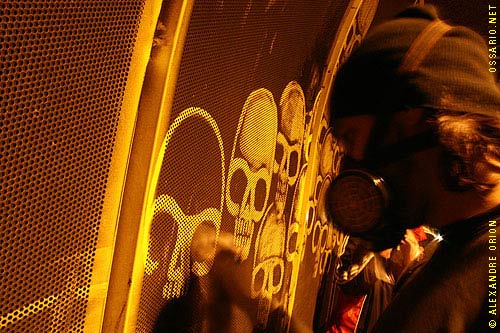

Alexandre Orion is cleaning São Paulo’s tunnels by scraping the deposited vehicle exhaust soot from the walls to make hundreds of sculls. Even so police turned up several times they couldn´t do much as cleaning is no crime. After some time the São Paulo municipal started their own cleaning mission, consequently only cleaning the parts already cleaned by Alexandre. Again the skulls appeared on the remaining soot canvas and this time the city decided to clean all tunnels.
It is predictable what will happen in some month.
go here for more images, video, texts and a description in Alexandre´s own words.
via
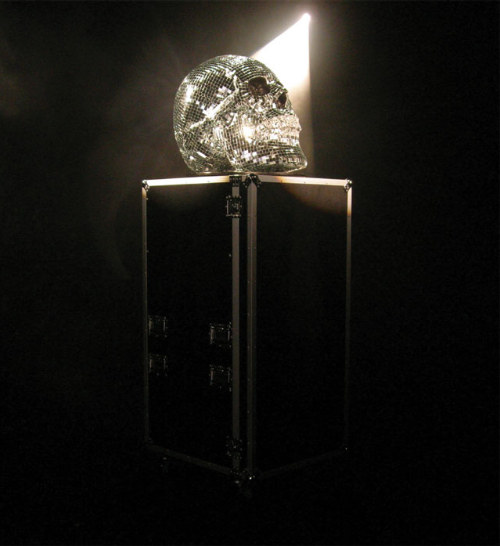 UNTITLED, Vanity Flight Case, 2005, flight case, resin skull, mirrors, motor, smoke, machine, spotlights, 77x31x27 ins (195.5x79x68.5 cm)
UNTITLED, Vanity Flight Case, 2005, flight case, resin skull, mirrors, motor, smoke, machine, spotlights, 77x31x27 ins (195.5x79x68.5 cm)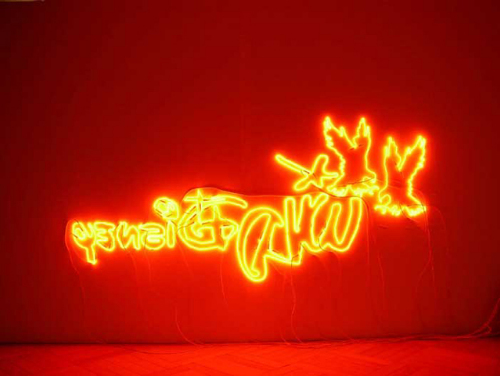 WILD DISNEY, 2003
WILD DISNEY, 2003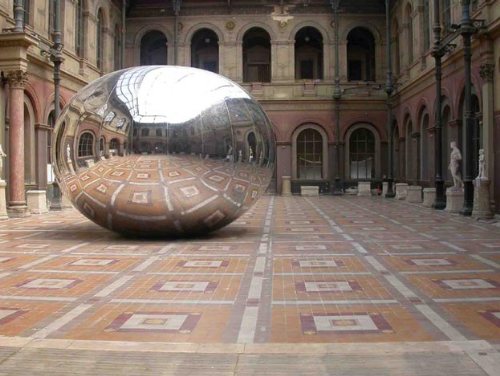 UNTITLED, SILENCE IS SEXY, 2004
UNTITLED, SILENCE IS SEXY, 2004 SANS TITRE, VANITYFAMESMILEYSADLEYMERCEDESJUNKJORDANMAGICTREE, 2006, Aluminium, peinture epoxy cuite au four, découpe jet d'eau haute pression
SANS TITRE, VANITYFAMESMILEYSADLEYMERCEDESJUNKJORDANMAGICTREE, 2006, Aluminium, peinture epoxy cuite au four, découpe jet d'eau haute pression THE BIG ONE WORLD, 2000, resin, edition of 3 ex + 2AP
THE BIG ONE WORLD, 2000, resin, edition of 3 ex + 2AP Platform level of Mirdamad station
Platform level of Mirdamad station Ceiling of Navoiy station
Ceiling of Navoiy station Mustaqilik Maidoni station
Mustaqilik Maidoni station One of the many optical illusions at Bayview station by artist Panya Clark Espinal.
One of the many optical illusions at Bayview station by artist Panya Clark Espinal. BOATS (2005), 125 x 188 cm, Photography on Alu-Dibond, ED. 3 + 1 AP
BOATS (2005), 125 x 188 cm, Photography on Alu-Dibond, ED. 3 + 1 AP TABLE 64283 (2004), 80 x 120 cm, Photography on Alu-Dibond, ED. 3 + 1 AP
TABLE 64283 (2004), 80 x 120 cm, Photography on Alu-Dibond, ED. 3 + 1 APWith Stefan Heyne, it seems to me as if the eye were coerced into watching itself seeing. One could speak of a doubled perception, of what one has before one’s (rain-veiled) eyes and of what the imagination is to achieve. The effect depends on this process of assimilation. Behind it is the search for an art for which commentary and conceptual considerations seem as important as what meets the eye. This kind of coercion of perception and of reading the image places accents in the direction of the unexpected...Heyne’s view of reality is made visible in fuzziness, in the way that, with the relativizing of the visible, one’s own groping in space for what is not obvious, for the mysterious and ephemeral, becomes an occasion for producing pictures.
Heyne also clarifies anew that photography, despite all appearances, is completely unsuited to conveying precise information. The only clear statement of which it might be capable is to say: I am a photograph – and not a painting... Of course, Heyne immediately defeats it again with its own weapons on his compositional stage of ambivalences.
from: Christoph Tannert, Indications of What is Not Obvious
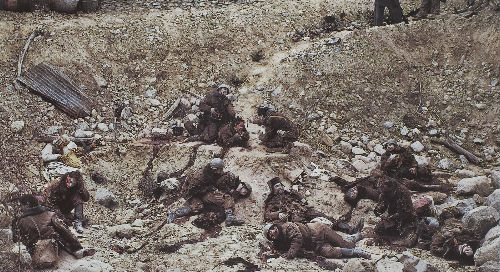 Dead Troops Talk (A vision after an ambush of a Red Army patrol, near Moqor, Afghanistan, winter 1986) 1992, 2290 x 4170 mm,Transparency in lightbox
Dead Troops Talk (A vision after an ambush of a Red Army patrol, near Moqor, Afghanistan, winter 1986) 1992, 2290 x 4170 mm,Transparency in lightboxIn Dead Troops Talk, Wall merges conventions from war and horror movies with those of the history painting of previous eras to create an elaborate, grotesque fiction. The picture presents a hallucinatory scene in which soldiers who have just been killed on the battlefield are re-animated, engaging with each other in what the artist describes as a 'dialogue of the dead'. As the title indicates, the troops are a Soviet patrol ambushed in Afghanistan during the war and occupation of the 1980s. Each figure or group seems to respond differently to the experience of death and reanimation. The three soldiers clowning with their own wounds provide a note of macabre levity. Wall has suggested that their black humour is as plausible a reaction to their circumstances as the more serious or distressed responses of their comrades. As carefully constructed as a film or epic painting, the work was shot in a large temporary studio, involving performers and costume, special effects and make-up professionals. The figures were photographed separately or in small groups and the final image was assembled as a digital montage.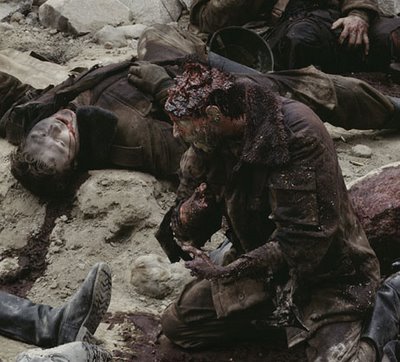 'The young boy, whose head is blown open and has lost his hands, is in a way the central figure, and he is saying something that he feels is urgent to the older captain but because the captain’s dead too, he's also moved into another dimension, one in which he doesn't have to answer. There's no urgency – he's contemplating this boy's questioning nature, or contemplating the urgency itself, who knows.' - Jeff Wall
'The young boy, whose head is blown open and has lost his hands, is in a way the central figure, and he is saying something that he feels is urgent to the older captain but because the captain’s dead too, he's also moved into another dimension, one in which he doesn't have to answer. There's no urgency – he's contemplating this boy's questioning nature, or contemplating the urgency itself, who knows.' - Jeff Wall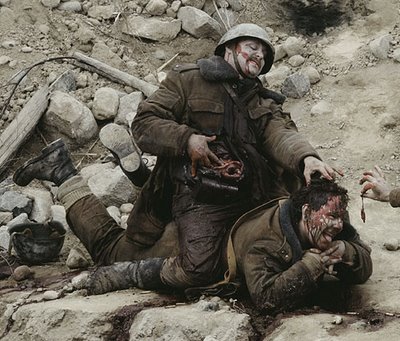 'I wanted to involve an element of levity, but without comedy... In any group of thirteen men, three at least are going to be complete fools. So it's likely they would remain fools even after death. On the other hand, maybe they weren't fools before, and only became so once they were killed.' - Jeff Wall
'I wanted to involve an element of levity, but without comedy... In any group of thirteen men, three at least are going to be complete fools. So it's likely they would remain fools even after death. On the other hand, maybe they weren't fools before, and only became so once they were killed.' - Jeff Wall
more about Dead Troops Talk and the work of Jeff Wall at Tate